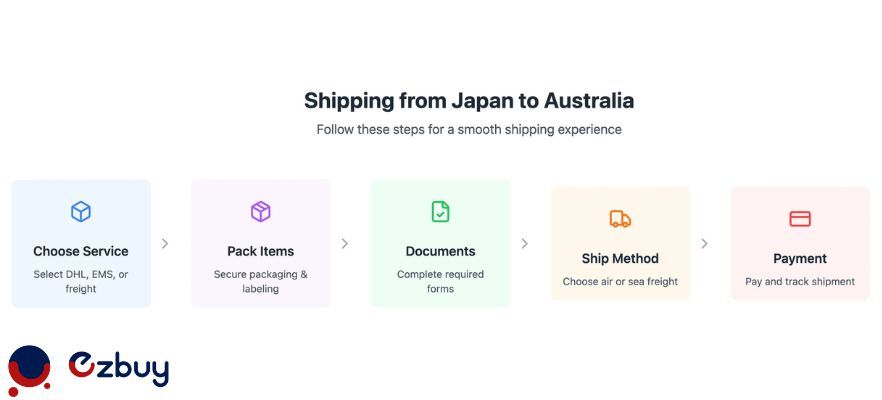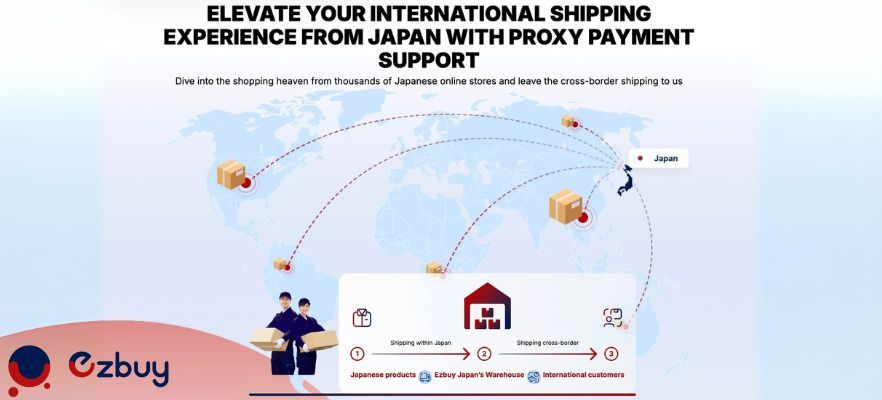Shipping From Japan to Australia: Everything You Need to Know
By Macy -18/02/2025 UTC.
Shipping goods from Japan to Australia doesn’t have to be complicated. Whether you’re purchasing unique Japanese products, managing an eCommerce business, or relocating personal belongings, understanding the shipping process ensures smooth delivery. This guide covers all aspects, including shipping from Japan to Australia costs, methods, customs regulations, and timelines so that you can ship confidently and efficiently.
1. Why Ship From Japan to Australia?
Japan offers exceptional products like electronics, fashion, and cultural items. The growing demand for Japanese goods in Australia has increased the need for reliable Japan to Australia shipping services, making it easier to ship personal or business items.
1.1. What are the benefits of sourcing goods from Japan?
1.2. What are the common use cases for shipping?
As the connection between Japan and Australia continues to strengthen, efficient shipping services make it easier than ever to access Japan’s distinctive products for personal enjoyment or business growth.
2. Shipping Methods From Japan to Australia
When shipping goods from Japan to Australia, the two main options are air freight and sea freight. Each method caters to different needs based on cost, urgency, and shipment size.

2.1. Air freight
Air freight is the fastest option, ideal for lightweight, high-value, or time-sensitive goods. Delivery times typically range from 2 to 7 days, making it perfect for urgent shipments.
Advantages:
- Ensures quick delivery for businesses or individuals with tight deadlines.
- Fewer delays due to strict schedules and efficient handling.
- Reduced risk of damage or theft during transit.
Drawbacks:
- Shipping from Japan to Australia price range from $20–$50 per kilogram, depending on the carrier and service level.
- Not suitable for heavy or large-volume shipments due to high costs.
Let’s make an example! A retailer in Australia orders 200 kilograms of electronics from Japan. Air freight at $25 per kilogram would cost $5,000, with delivery in 3–5 days, ensuring quick restocking for high-demand items.
2.2. Sea freight
Sea freight is cost-effective for bulky or non-urgent goods, with delivery times of 2–4 weeks. This method works well for large volumes or heavy items like furniture or machinery.
Advantages:
- Costs start at $200–$500 per cubic meter (CBM), significantly cheaper for large shipments.
- Handles bulky and heavy goods without strict weight limitations.
- Offers Full Container Load (FCL) or Less Than Container Load (LCL) based on shipment size.
Drawbacks:
- Transit times are much longer compared to air freight.
- Weather, port congestion, or customs clearance can extend delivery times.
Common use cases:
- Businesses importing furniture, machinery, or bulk inventory.
- Individuals shipping personal effects during relocation.
- Wholesale traders moving large shipments of goods.
Here’s an example: Sea freight is cost-effective for bulk shipping items from Japan to Australia, such as furniture or machinery. Shipping 10 cubic meters (CBM) would cost around ¥300,000 (~A$3,000) and take 2–4 weeks.
For shipping from Japan to Australia, let’s choose air freight if:
- You need shipping from Japan to Australia time within 7 days.
- Your items are lightweight, high-value, or time-sensitive.
- You’re willing to pay a premium for speed.
Let’s choose sea freight if:
- Your shipment is bulky or heavy, and cost is a priority.
- You can wait 2–4 weeks for delivery.
- You’re shipping large quantities, such as wholesale goods or personal effects during relocation.
3. How Much Is Shipping from Japan to Australia?
Shipping goods from Japan to Australia involves various options, each suited to different needs, budgets, and delivery times.
3.1. Air freight
Air freight is the fastest but most expensive shipping method. It is ideal for urgent, lightweight, or high-value items. Costs depend on shipment weight, service levels, and the provider.
If you need to send 100 kg of electronics urgently, choosing FedEx International Economy would cost approximately A$2,274, with delivery in 3–7 days.
3.2. Sea Freight
Sea freight is a cost-effective option for bulky or heavy shipments. It is slower but significantly cheaper, making it ideal for larger volumes or non-urgent items.
Shipping 10 cubic meters (CBM) of furniture via LCL might cost A$3,000, with delivery in about 3–4 weeks.
3.3. Postal Services
Japan Post provides economical options for smaller packages. Delivery speeds and costs vary by service.
If you’re shipping a 2 kg parcel of gifts, EMS would cost ¥4,300 (approx. A$45), with delivery in about 8–9 days.
Important notes: When planning your shipment, consider the following additional charges:
- Goods valued over AUD $1,000 may incur import duties and GST upon arrival in Australia.
- Optional but recommended for high-value items.
- If paying in Japanese Yen, currency conversion fees may apply.
- Custom packaging to secure fragile items may add to the total cost.
>>> Read more: Shipping From Japan To US: Guide, Services & Tips To Reduce Costs
4. Step-by-Step Guide to Ship From Japan to Australia

Step 1: Choose a reliable shipping service
Why is choosing the right service important? The shipping provider you select can significantly impact the cost, speed, and reliability of your shipment. It’s essential to evaluate your options carefully.
Key considerations when choosing a service:
- Cost: Compare rates and services to find the most economical option.
- Speed: Choose express services for time-sensitive shipments or standard options for cost savings.
- Tracking and support: Opt for providers offering real-time tracking and responsive customer support.
Here is our recommendation for shipping providers from Japan to Australia:
- DHL and FedEx: Known for fast and reliable international services.
- EMS: Cost-effective for personal packages.
- Freight Forwarders: Ideal for large shipments or bulk imports.
Step 2: Prepare your items for shipping
Why is proper preparation crucial? Proper packaging protects your goods during transit and ensures compliance with shipping regulations.

Tips for effective preparation:
- Use sturdy materials: Choose strong, durable boxes and bubble wrap to prevent damage.
- Secure fragile items: Wrap delicate items individually and add cushioning to avoid breakage.
- Label packages clearly: Include the recipient’s full address, contact details, and any handling instructions.
When preparing items for shipping, it's important to remember some common restrictions. First, avoid wrapping items in materials prohibited by customs. Additionally, it’s crucial to package your items according to the guidelines set by your shipping provider. Packing items correctly not only helps reduce the risk of damage but also speeds up the customs processing time.
Step 3: Complete the required documentation
Accurate documentation is critical to ensure that your shipment clears customs smoothly. Missing, incomplete, or incorrect paperwork can lead to shipment delays, penalties, or even the confiscation of goods.
Customs declaration form
The declaration form provides detailed information about the shipment, including its contents, value, and purpose.
For example, if you’re shipping a package through EMS (Japan Post), you’ll need to complete a CN22 or CN23 customs declaration form. This includes:
- Description of goods (e.g., "10 ceramic cups").
- Total value (in Japanese yen or AUD).
- Purpose (e.g., "Gift" or "Commercial Sale").
Commercial invoice (for business shipments)
A commercial invoice is a detailed invoice for business shipments that lists the items, their value, and the terms of sale.
For example, if you’re using DHL for a bulk shipment of electronic components, you must include a commercial invoice that states:
- Item details (e.g., "50 Bluetooth speakers").
- Value (per unit and total).
- Harmonized System (HS) code for classification.
Packing list (for bulk shipments)
A packing list is a document that details how the items are packed and arranged within the shipment, which is especially useful for larger orders.
For example, freight forwarders like Nippon Express often require a packing list when shipping goods like furniture or automotive parts. The list might include:
- Number of boxes (e.g., "5 cartons").
- Dimensions and weight of each box.
- Detailed inventory (e.g., "Carton 1: 10 chairs, Carton 2: 5 tables").
Step 4: Select the Right Shipping Method
How do you choose between air freight and sea freight? The choice depends on your priorities: speed, cost, and the nature of the items being shipped.
Let’s explore two scenarios for each shipping method.
Example scenario 1: Urgent, lightweight shipment
In this case, a small business in Australia orders 50 high-end cameras from Japan, weighing 200 kilograms. The shipment needs to arrive within 5 days.
Choice: Air freight
- Cost estimate: 200 kg × $25/kg = $5,000
- Delivery time: 3–5 days
Why air freight? The cameras are high-value items, and their lightweight nature makes air freight cost-effective for the urgency required.
Example scenario 2: Bulk shipment of furniture
In this case, an importer in Australia purchases 10 dining tables from Japan. The total volume of the shipment is 5 CBM, weighing 1,000 kilograms. The shipment isn’t time-sensitive.
Choice: Sea freight
- Cost estimate: 5 CBM × $300/CBM = $1,500
- Delivery time: 3–4 weeks
Why sea freight? The shipment is heavy and bulky, and sea freight significantly reduces costs compared to air freight.
Step 5: Make payment and finalize the process
Now, how do you finalize your shipment? After choosing your provider and preparing your items, you’ll need to complete payment and finalize the shipment details.
Here are the steps to finalize the process:
- Calculate the total cost, including shipping fees, customs duties, and optional insurance.
- Choose the payment method your provider accepts (e.g., credit card, bank transfer).
- Confirm all shipment details, including the recipient’s address and contact information.
To avoid delay, you should definitely:
- Double-check all forms and ensure the payment is processed correctly.
- Keep a copy of the shipping receipt and tracking number for reference.
After all, careful planning and attention to detail at each stage will help avoid delays, reduce costs, and guarantee a successful delivery.
5. Customs Regulations and Prohibited Items
Navigating customs regulations is critical for ensuring your shipment from Japan to Australia is processed smoothly. Being aware of the rules and restrictions helps avoid delays, fines, or confiscation of goods.
5.1. Australian customs regulations
Customs declaration:
All shipments entering Australia must include a detailed customs declaration form outlining:
- The type of goods being shipped.
- Their declared value (in AUD).
- The purpose of the shipment (e.g., personal, commercial).
Duties and taxes:
- Goods valued over AUD $1,000 are subject to Goods and Services Tax (GST) and import duties.
- Certain items may attract additional tariffs, depending on their classification.
Biosecurity inspections:
Australia’s Department of Agriculture, Fisheries, and Forestry (DAFF) inspects shipments for items that might pose a risk to the environment, such as plants, food, or wooden products.
Restricted and prohibited goods:
Certain goods are subject to additional permits, while others are strictly prohibited from entering Australia.
5.2. Prohibited and restricted items
Prohibited items
Items that are strictly banned from import include:
- Weapons and explosives: Firearms, ammunition, and certain types of knives.
- Illegal substances: Drugs and unapproved chemicals.
- Counterfeit goods: Items that infringe intellectual property laws.
Restricted items
These items require special permits or conditions for import:
- Food and plant products: Fresh fruit, seeds, and untreated wood.
- Animal products: Meat, dairy, and other animal-derived goods.
- Lithium batteries: Subject to specific packaging and labeling requirements.
Here are examples of restricted goods:
6. How Ezbuy Japan Simplifies the Process
At Ezbuy Japan, we specialize in reliable Japan to Australia shipping services, handling everything from packing and documentation to customs clearance. Our flexible options include air and sea freight, with real-time tracking for a hassle-free experience.

Comprehensive handling of the shipping process
From pickup to delivery, we take care of everything. This includes secure packing, preparing accurate documentation, and liaising with customs authorities to streamline the entire process.
Flexible packaging solutions
We offer tailored packaging options to suit your shipment’s specific needs, whether it’s fragile items requiring extra care or bulk goods needing durable packaging.
Effortless customs clearance
Our expertise in customs regulations ensures compliance with Australian import laws. We manage all necessary documentation, reducing the risk of delays or penalties.
Real-time tracking features
Our advanced tracking system allows you to monitor your shipment at every stage, providing transparency and peace of mind until your package is delivered.
At Ezbuy Japan, we are committed to offering efficient and reliable solutions for all your shipping needs. Explore our services and see how we can simplify your logistics at Ezbuy Japan.
>>> Relevant reading: Ship overseas from Japan using Ezbuy Japan's cross bodder shipping service.
7. FAQs
7.1. What are the main shipping options from Japan to Australia?
The primary options are air freight, sea freight, and postal services. Air freight is the fastest but more expensive, sea freight is ideal for bulky shipments and cost savings, while postal services like EMS are affordable for smaller packages.
7.2. Can I ship personal items from Japan to Australia?
Yes, personal items such as gifts, clothing, or household goods can be shipped. Choose the method based on the size, weight, and urgency of your shipment. EMS and air freight are popular choices for smaller parcels.
7.3. Are there size or weight limits when shipping from Japan to Australia?
Yes, limits vary by shipping provider. For example, EMS allows packages up to 30 kg, while air freight and sea freight options can accommodate much larger shipments, including full containers.
7.4. What is the best way to ship bulky or heavy items to Australia?
Sea freight is the best option for bulky or heavy items like furniture or machinery. It offers cost-effective rates starting at ¥30,000 (~A$300) per cubic meter, though it takes 17–25 days for delivery.
7.5. How long does shipping take from Japan to Australia?
Delivery times vary depending on the shipping method:
- Air freight: 3–7 days, ideal for urgent shipments.
- Sea freight: 17–25 days, suitable for bulk or non-urgent goods.
- EMS or airmail: 8–9 days, a good mid-range option for smaller packages.
- Surface mail: Up to 2 months, the most economical but slowest option.
7.6. Do I need to handle customs clearance when shipping to Australia?
Yes, all shipments must go through customs clearance. You’ll need accurate documentation, including a customs declaration form, commercial invoice (for business items), and a packing list for larger shipments. Shipping services like Ezbuy Japan often assist with customs processes.
8. Conclusion
Shipping from Japan to Australia doesn’t have to be complicated. It can be seamless with the right approach. By choosing the best shipping method for your needs, preparing accurate documentation, and understanding customs regulations, you can avoid delays and extra costs.
For a hassle-free experience, Ezbuy Japan offers reliable solutions, handling everything from packaging to customs clearance to ensure your shipment arrives safely and on time.
Website: https://ezbuy.jp/en
Email: [email protected]